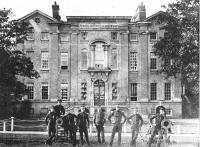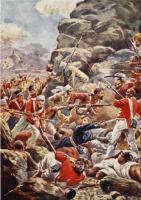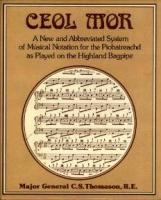
Nat Gould
His life and books
Charles Simeon Thomason 1833-1911
| Charles Simeon Thomason |
|---|
| Born: 1833 |
| Died: 1911 |
| Father |
| James Thomason 1804-1853 |
| Mother |
| Maynard Eliza Grant |
| Siblings |
| James Grant Thomason 1830- |
| Maynard Montier Thomason 1831- |
| Charles Simeon Thomason 1833-1911 |
| William Stephen 1835- |
| Emma Frances Thomason 1837- |
| Rowland Fawcett Thomason 1838-1850 |
| Spouse |
| Ellen Fanshaw Dundas Drummond 1832-1899 |
| Children |
| Annie Grant Thomason 1860- |
| James Grant Thomason 1861- |
| Rowland Maxwell Thomason 1865-1911 |
| Archibald Fawcett Thomason 1866-1935 |
| Ellen Effie Thomason 1869- |
| Bessie Drummond Thomason 1870-1947 |
Charles Simeon Thomason was born on 25 May 1833 at Azimghur, Bengal in India, the son of James Thomason and his wife nee Maynard Eliza Grant. He was baptised there on 10 November 1833.
His mother died when he was only aged six years, and he was sent to Scotland to the care of her parents at Wester Elchies on Speyside. There he acquired his great love of Scottish music, taking lessons on the flute and bagpipe.
In 1849 he entered Addiscombe Military Academy (1) as a cadet on the recommendation of his aunt Mrs Stephen (2). On 12 June 1852 he was commissioned in the Bengal Engineers, and after studying at Chatham sailed for India in 1854. So began not only a distinguished military career but also his love of classical bagpipe music, the pibroch or piobaireachd (). While at Chatham he met regimental pipers, and when on leave in Edinburgh took lessons from the brother of Donald Cameron, champion piper of Scotland.
Thomason took with him to India his grandfather's pipes and a quantity of music, much copied out by himself. Unfortunately all was lost in the Indian mutiny at Delhi on 11 May 1857. He himself survived the massacre only because he was in hospital outside the city walls. His local knowledge gained from engineering work proved invaluable in enabling a small British column to re-take a base for the siege of Delhi. For the next three months he made surveys, often on foot within snipershot of the walls, to make good the deficiency of maps. When the Kashmir Gate was stormed on 14 September 1857 Thomason was among the few engineer officers to survive. With difficulty he resumed his surveying work, but was involved in another battle in January 1858.
Thereafter his military career led up to the rank of Major-General, planning and supervising irrigation, roads, harbour defences, and building projects, important not only for defence but also for the developing health and communications throughout India. However he is better remembered now for his collection of piobaireachd music (Ceol mor) than for his military service.
He married Mrs Ellen Fanshawe Dundas Drummond 1832-1899 on 20 September 1858 (3). Her maiden name was Boisragon, and she was of Huguenot descent. She was the widow of Major James Drummond of Balquahandy and Aberuchill, Perthshire. In 1861, while on sick leave in Scotland, he built Laggan Lodge, near his Speyside childhood home. He began to replace his lost music collection, helped by Donald Mackay. Back in India, he was further assisted by pipers of the Highland Light Infantry. Determined that piobaireachd playing should not die out and old tunes be lost, he devoted all his spare time to preparing his collection for publication.
In 1888 Thomason moved to Naini Tal in the Kumaon hills on half pay to work on the book, inventing a shorthand notation that would allow 280 tunes to be compressed into one manageable volume. He was helped by his children Archibald and Bessie. A pilot pamphlet was produced in 1893. The task continued when he retired to England in 1895. Ceol mor was published in three parts in 1897, then as one book in 1900, and finally with a revised notation in 1905. Its appearance was greeted with enthusiasm, and Thomason became first president of the new Piobaireachd Society. However his book was criticised on the grounds that his life in India had deprived him of knowledge of Angus Mackay's manuscripts, leading him to rely too much on Donald MacDonald's less preferred settings, and because he had corrected what were to him obvious mistakes in old respected settings.
Nevertheless Ceol mor (meaning great music) preserved many rare tunes and introduced abbreviated notation and a classification system that aided memorising and expression. The book was republished in 1975.
His tall figure in Grant tartan was a familiar sight at highland games, and his contribution to piping was recognized by the presentation of an illuminated address on 1 July 1909 (4).
Charles Simeon Thomason and his wife nee Ellen Fanshaw Dundas Boisragon had the following children:
Annie Grant Thomason. She was born in 1860.
James Grant Thomason. He was born in 1861.
Rowland Maxwell Thomason. He was born in 1865. He married Florence Ellen Lukis on 28 March 1894 in Jaipur India. He died in 1911.
Archibald Fawcett Thomason. He was born in 1866 and died in 1935.
Ellen Effie Thomason. She was born in 1869.
Bessie Drummond Thomason. She was born in 1870. She was married to Clifford Beckett. She died in 1947.
Their father Charles Simeon Thomason died on 12 July 1911 at 103 Warwick Road, Kensington in London, and was buried on 15 July in Inverallan churchyard, Grantown-on-Spey in Scotland.
(1) Addiscombe Military Academy, near Croydon in Surrey, was founded in 1809 by the East India Company for training engineer officers, and continued even after the Company was wound up in 1858. It closed in 1861, however, and most of the buildings were demolished. The photograph shows cadets at the academy in about 1859. The prominent motto reads "Non faciam vitio culpave minorem" (I will not lower myself by vice or fault). For an account of the academy see The East India Company's Military Seminary, Addiscombe, 1809–1858 by J.M. Bourne in the Journal of the Society for Army Historical Research volume 57 (1979) pages 206 to 222.
(2) His cadet's certificate dated 1849 is in the British Library : Reference L/MIL/9/222, f.379. His aunt Esther Stephen was the sister of his father James Thomason 1804-1853.
(3) Transcription of Bengal Marriage Indexes 1857-1864 volume 65 folio 62: Families in British India Society Database http://search.fibis.org
(4) Oxford Dictionary of National Biography (2004): article by B. D. Mackenzie, based on Ceol mor notation: a new and abbreviated system of musical notation for the piobaireachd by Charles Simeon Thomason (1893) reprinted (1975); Mutiny Memoirs of Major General Charles Simeon Thomason R.E. (Bengal) B. D. Beckett (1907); Piobaireachd: a Crack with Brother Pipers by Charles Simeon Thomason; The First Hundred Years: a History of the Royal Scottish Pipers' Society by B. D. Mackenzie (1983) chapter 5 ; Personal Memoirs by B. D. Beckett chapter 17; The Kilberry Book of Ceol mor by A. Campbell (1948); articles in Strathspey Herald dated 3 August 1911, in The Times dated 14 July 1911, and The Scotsman dated 14 July 1911; List of Officers of the Bengal Army, 1758–1834 by V.C.P. Hodson in four volumes (1927–47); Addiscombe: its heroes and men of note by H. M. Vibart (1894); the manuscripts of Donald MacDonald in the National Library of Scotland; and the manuscripts of the Piobaireachd Society. A photograph of Charles Simeon Thomason circa 1890 was reproduced in The First Hundred Years: a History of the Royal Scottish Pipers' Society by B. D. Mackenzie (1983), and another taken circa 1900 in Piping Times in June 1975.
See also Beautiful and Melodious Airs, an Exploration of Piobaireachd Series III by Dr. William Donaldson, published in Piper and Drummer Magazine (2002-2003) http://www.pipesdrums.com



